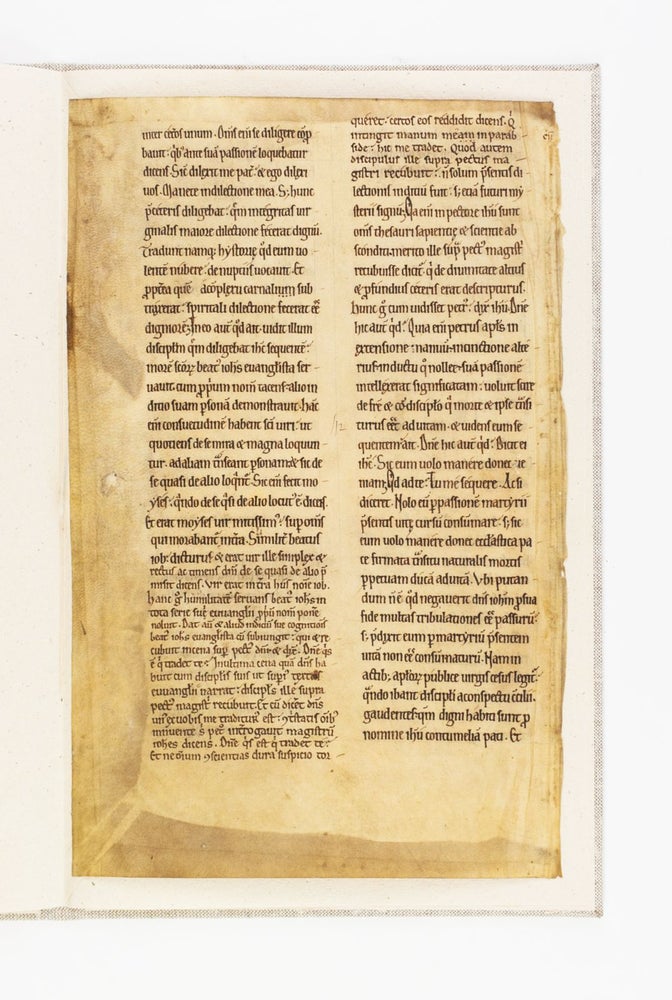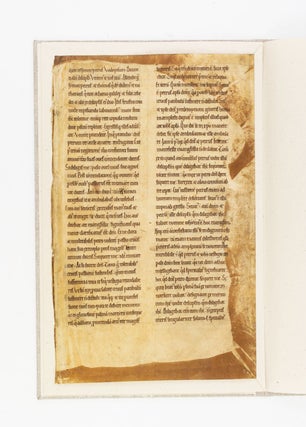WITH TEXT FROM HAIMO'S HOMILY XI ON ST. JOHN THE EVANGELIST.
(England: second half of 12th century [but before 1180]). 313 x 198 mm. (12 1/4 x 7 3/4). Double column, 32 lines in a lovely late Caroline hand (verso with some lines erased and corrected in a smaller hand).
Mounted in a fine tan cloth folder between sheets of textured acid-free paper. Front pastedown with book label of the Schøyen Collection, with their shelf mark MS 237 written in ink. ◆Recovered from a binding and thus with overall toning and soiling (recto somewhat browned from binder's glue, but almost entirely confined to three margins, and the verso virtually unaffected), other trivial imperfections, but in surprisingly good condition given its history, the very rich ink especially dark and well preserved.
This is an exceptionally lovely example of an early English book hand, standing at the crossroads of the Caroline and proto-gothic calligraphic traditions. According to Thompson, "In the twelfth century the scribes seem to have vied with each other in producing the best types of book-writing of which they were capable, with the result that remarkable precision in the formation of the letters was attained, and that the century may be named as excelling all others for the beauty of its MSS." ("Greek and Latin Paleography," p. 436) The present leaf certainly lives up to this description, being notable for its exceptionally neat and legible script, written with uncommonly pretty and regular letter forms by a practiced and confident hand. The Caroline tradition is apparent in certain tendencies such as the use of "&" for "et" and the lack of biting curves between letters, while a shift toward the proto-gothic can be seen in the vertical and compressed letter forms, as well as the increased use of abbreviations and ligatures. Although the present work has often been credited to Haymo of Halberstadt (due to a longstanding error in attribution reaching back to the 15th century), modern scholarship now recognizes Haimo of Auxerre, a monk at the Abbey of Saint-Germain in Auxerre (d. ca. 875), as its true author. A prominent theologist and writer during the Caroline Renaissance, Haimo produced a number of influential commentaries on various books of the Bible. The provenance on this leaf can be traced back as far as the mid-19th century, when it was auctioned at Sotheby's on 21 August 1858 (lot 119.2), sold as part of an album containing various leaves and fragments put together by Philip Bliss (1787-1857), registrar of the University of Oxford. It then went into the celebrated collection of Sir Thomas Phillipps (1792-1872), and was eventually sold by the Robinson Brothers on 24 April 1911 (lot 390.3). This leaf has previously appeared in Quartich's catalogue 1036, "Bookhands of the Middle Ages" (no. 79.5), and was most recently in the collection of Martin Schøyen (his MS 237). (ST17768)
Price: $7,500.00


